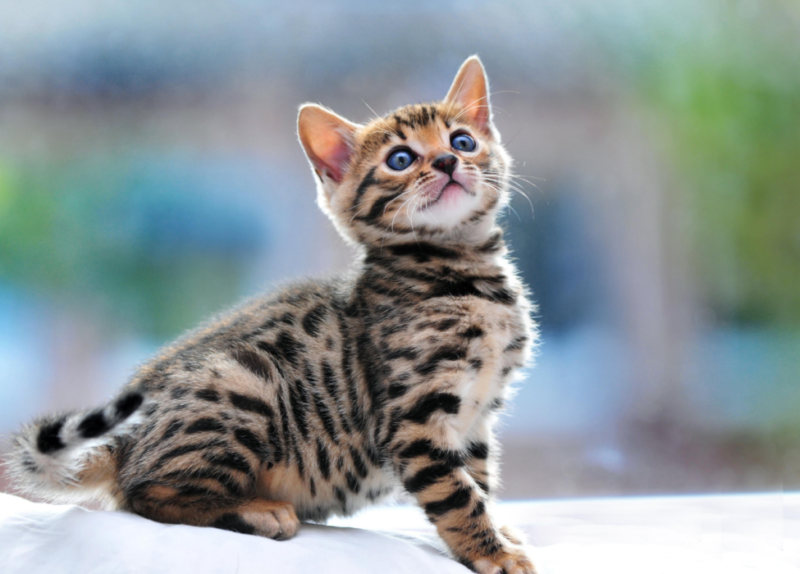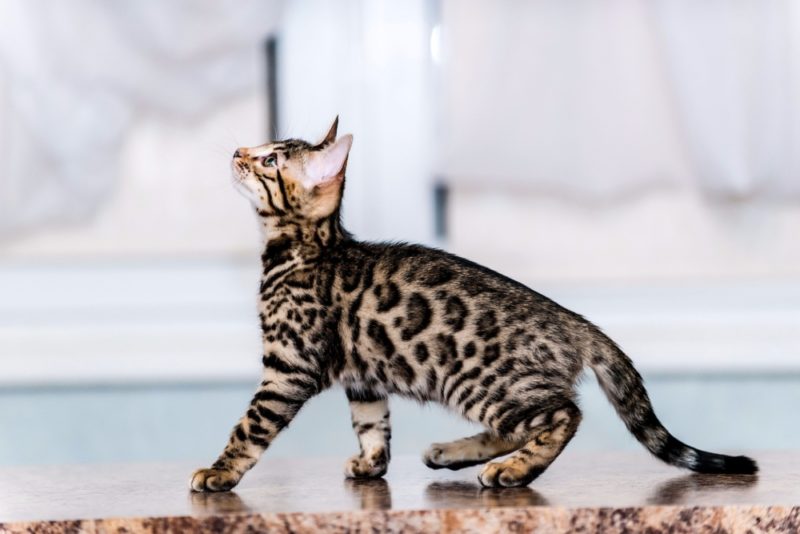Bengal kittens stand out among other cat breeds. The playful character and noble appearance made these pets popular around the world. However, a thoroughbred cat requires special attention. Having studied all the intricacies of care and nutrition, you can create ideal conditions for your beloved pet, for which he will thank the owner with attention and mischief.
Material Content:
Description and characteristics of the breed
Bengal kittens are fascinated by a graceful look. Outwardly resemble mini leopards. The mass of an adult cat is up to 10 kg, cats - up to 7 kg. The wedge-shaped head, almond-shaped eyes - all this gives the animal a special look. Pointed ears are always inclined forward, which indicates a willingness to respond extremely quickly to any rustle. The standard eye color of a natural Bengal breed is green or golden. The body is muscular and elongated. The coat is pleasant, smooth and silky to the touch; it has a pattern similar to that of wild cats.
Important. A hybrid of this breed can have any coat color except blue.
The paws of the pet are quite sinewy, long, which allows him to make excellent high jumps. The thin tail is of medium length.
Cats are very smart and curious. Can be trained, kind and devoted.
Note. Bengal is such a friendly type of cat that it can coexist under one roof with any other animal.
Origin history
The history of origin begins in 1961. Breeding, as a science, was on the verge of development, and the American genetic biologist Gene Mall, by chance, ended up in Bangkok. Wild cats were in the process of extinction due to poaching.Gene acquired a British kitten and took with her to America. Malaysia (such a nickname the breeder gave the animal) differed from the ordinary cat, who had previously lived with a biologist, in its wild character.
In 1963, interbreeding occurred. A spotted kitten hybrid Kin-Kin was born. Such an event prompted the breeder to breed a new, domesticated breed of cat that looks like forest residents. The confluence of life circumstances influenced further work, and Jin transferred Malaysia to the zoo.
The mating experiment was continued 15 years later, when scientists decided to conduct a study of the immunity stability of wild and domestic cats. In the course of interspecific crossing of wild leopard females and domestic cats, scientists received first-generation hybrids. She was handed over by nine females, and she then came to grips with breeding bengals, crossing her pets with breeds such as Burma and Mau. Having visited the Indian Zoo in 1982 and fell in love with a Mau kitten with a golden orange color, Jin took him to her, giving the nickname Delhi.
Subsequent breeding crosses of the first subspecies began to occur with Delhi. So the first individuals of a true Bengal breed were born, conquering the whole world.
Bengal cat color
The Bengal muzzle has a classic color, which is characterized by the “tabby” pattern: the dark and pronounced letter “M” on the forehead. A “necklace” pattern should be visible on the neck, and spots and stripes of small sizes on the shoulders. The paws of such an animal are spotty or striped. The tip of the tail is always black. The wool pattern has quite distinct and contrasting lines, never merged.
Depending on the basic wool pattern, bengals are divided into cats having:
- marble color - beautiful dark spots, different in shape and size, scattered throughout the body:
- silver (shiny cat) - spots are light, but with a clear dark border;
- snow - spots are almost invisible, only the contours are visible.
Note. Blue color is recognized only by one of the international felinological systems (TICA). And the color of melanists is still at the recognition stage.
Content Features
Bengal cats are naturally endowed with good health and high immunity. Despite this, timely vaccination will help the pet avoid the most dangerous cat infections. Wearing an anti-flea collar on the street while walking will protect the cat from skin parasites.
Bengal kitten is overly active. If there are children in the house, then this pet will become their best friend. Up to 8 months, kittens are completely unable to sit still, constantly in motion, and play most of the time. There’s more than enough energy. So that the pet does not harm the furniture, it is worth getting special toys.
Recommendation. Bengals are a domesticated species of wild cats. Try to take your pet out more often. Be sure to use a leash, because the nature of cats of this breed is quite freedom-loving.
Care, health and nutrition
The Bengal cat breed is the only type of domestic cat that loves water. They can be bathed more often than other smooth-haired representatives. Wool must be combed out once every 10 days.
If a cat of a leopard color is accustomed to walking on the street, then there is no need to trim the claws, as they grind during an active walk in a natural way. Otherwise, you can’t do without a clipper.
Nutrition is the key to feline health. Feeding Bengal kittens from childhood is right. Most of the main diet should be natural proteins, the lack of which will affect health.
Important! The digestive system is the only weak spot in this breed.
What should be excluded from the diet of bengals:
- fat meat;
- high fat sour cream;
- spice;
- oily fish.
It should be understood that wild genes flow in the blood of this breed. Therefore, every day the cat is required to receive lean meats.The ideal option would be a rabbit, turkey and tender chicken. Fish is given no more than 1-2 times a week. At the same time, fermented milk components must be a mandatory product in a cat's meal. Older cats are fed minced meat from lean meat, vitamins are added. Replace such a diet can be a balanced dry food developed specifically for this breed.
Proper care of the pet will extend his life to 20 years.
Recommendation. Urgently consult a veterinarian if a Bengal cat is no longer active, has a lethargic appearance and a dry nose.
Breeding
Bengal males develop faster than females. The estuary begins closer to the year of life. Interest in the opposite sex is approximately 4 times a year.
To understand that the female is ready for mating, it is worth highlighting four stages:
- Proestrus - for three days the cat shows affection, rubs against objects, but is not ready to let the male close to itself.
- Estrus - female is ready for mating. Allocated for this period from 4 to 8 days.
- Metestrus - the cat is calm and satisfied. Mating is over.
- Anestrus - the period between estrus.
Important. Discharge in cats during estrus is practically absent or they are transparent, in an insignificant amount. If spotting was noticeable in the mucus, you should definitely contact your veterinarian.
How to choose a kitten? This is a question that worries many cat lovers. You need to know that breeding is considered permissible only for thoroughbred bengals, otherwise not considered a priori. Finding such a cat / cat is quite problematic. When purchasing a Bengal, it is worth familiarizing yourself with his pedigree, where there is all the important information about him. It was established that the third generation of cats at the genetic level is not able to reproduce offspring or it dies, reaching certain months of life. If, when choosing a pet, the goal is not to leave the kids after him, then this genetic feature can be ignored.
Typical breed diseases
Bengal's health is excellent, but there are still cases when, due to heredity, improper care or nutrition, cats undergo diseases typical of their breed:
- intestinal inflammation is the result of eating fatty foods, an insufficient amount of water drunk by a pet;
- increased sensitivity of the stomach - to prevent gastrointestinal tract disorders, only freshly prepared food, fresh food is needed (otherwise poisoning the pet is not excluded);
- heart disease - inherited, incurable.
When deciding to get an animal of this breed, think about it, but are you ready to be responsible for taming it? If you confidently say “Yes!”, Then you and your beloved pet will be best friends for many years.

















